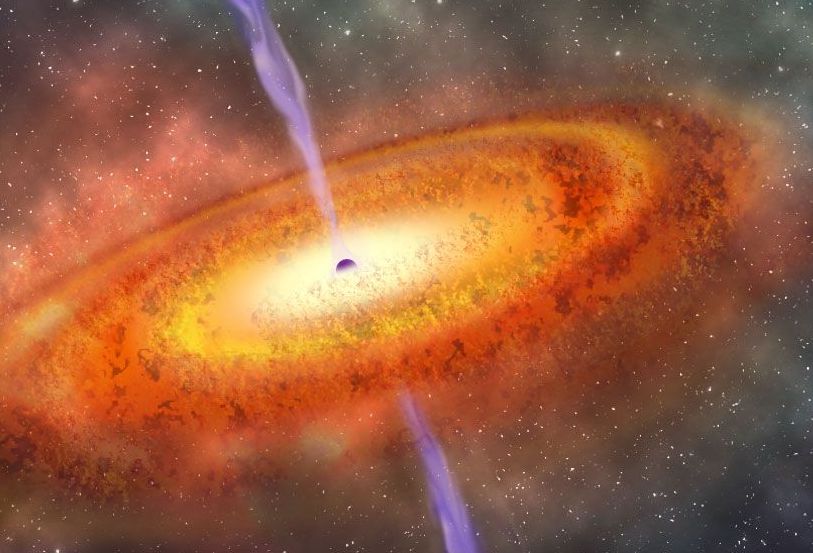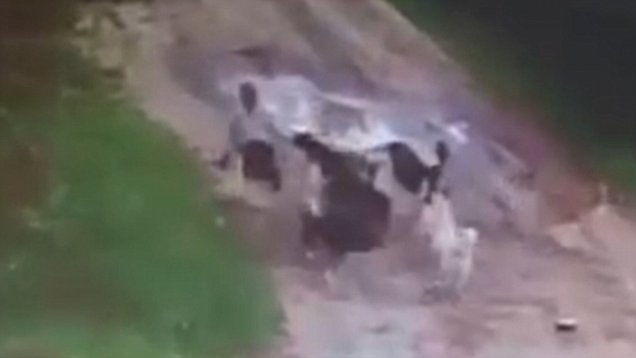
Oldest monster black hole ever found could ‘prove Big Bang never happened’.
The revelation, published in the journal Nature, comes out of observations that researchers made earlier this year of a gargantuan black hole at least 13 billion years old and 800 million times the mass of the sun.
The thing is a deep-space enigma: researchers are baffled how a black hole could have gotten so massive within several hundred million years of the Big Bang. But even more exciting than the black hole itself is the luminous disk of gas orbiting it—combined, the black hole and gas disk form a system called a quasar, and this one is shedding new light on the early cosmos.
Astronomers started by studying the quasar’s emission spectrum, from which they could figure out how fast the system is moving away from us. Because of how the universe expands, this value directly relates to how distant the quasar is from us, which the scientists calculated to be 13 billion light years. That, of course, gives us its age: the light took 13 billion years to reach our telescopes.
About 13.7 billion years ago, there was a Big Bang, which created a mess of subatomic particles. After things began to cool, these particles came together to form lots of hydrogen and some helium. But the new observations have revealed the hydrogen in the early universe was far different from most of the hydrogen in outer space today. Almost all the hydrogen atoms we’ve observed in intergalactic space have lost their electrons, giving them a positive charge. About half the hydrogen atoms near this quasar, however, are neutral, which means they’re still holding onto their electrons.
When light hits a neutral hydrogen atom, the atom can absorb the light and lose its electron. Afterwards, the light moves through the hydrogen fairly freely. But when scientists were studying the quasar, they realized they were viewing through a region of outer space that was still extremely opaque, full of neutral atoms. Meaning, it had never been exposed to light before.
In other words, it appears that that 13 billion years ago there weren’t lots of stars yet.
“This actually suggests we’ve measured, to within one or two percent accuracy, the moment at which starlight first illuminated the universe,” says Dr. Robert Simcoe, a physics professor at MIT and one of the authors of the study. “We’re used to the idea of the stars being almost eternal, but there actually was a time before there were any stars, when the universe was dark. And we now think we have a pretty good sense of when that transition took place.”
“The very early universe was extremely boring, because there’s only neutral gas floating around, and the only thing that was happening was these small clumps [of matter] were forming,” says Bram Venemans, a co-author on the paper and a research staff scientist at the Max Planck Institute for Astronomy. “Something only started to happen when the first star formed and you got radiation that started to ionize everything.”
It’s still unclear how exactly a supermassive black hole formed without many stars in the universe. When you think of a black hole, you’re likely thinking of a stellar black hole, which forms when a star explodes in a spectacular supernova, and the remaining core collapses under the weight of its own gravity. Supermassive black holes like this one are different: what must have happened, scientists think, is the black hole started much larger than a typical supernova remnant—perhaps forming directly from a huge amount of gas that never became a light-producing star. Or if not, it must have found a novel way to grow astonishingly fast.
No one’s sure exactly how those processes might happen, but researchers plan to look for more, similar deep-space objects to test their theories.













